When people talk about their fire experience many comment on the “Big Red Glow” that is synonymous with what people can see, especially at night or at times when fire activity creates premature darkness, marking the proximity of fire for people.
This is the story of our experience of actually being in that Big Red Glow at Sarsfield on Monday 30 and into Tuesday 31 December 2019.
My husband Anthony and I thought it was worth telling our story – it is a positive one – and something that may be of interest to others. We fully appreciate that the experience we had is not something that would be appropriate or even possible for everyone. It does show what good planning can mean for effectively defending your property. We learned quite a few things that we thought were worth recording as well.
Beyond the actual fire experience, we also wanted to observe the impact to our bush and to take a real interest in the way that it recovers, and how we reconnect with it as a key reason for living in such an amazing natural environment.
We also recognise the significant impacts that people across our community are dealing with too. The devastation and loss is so substantial, and we will be keen to understand how we can contribute to the safe and sustainable recovery of individuals and places in East Gippsland.
The content that follows may be confronting or distressing as it shows footage of actual fire activity up close. Please exercise judgement about reading further if you think you might find this distressing.
Images in this blog can be shared freely, however, attribution to Kate Nelson Consulting with a link to www.katenelson.com.au must be included when sharing.
What drives our approach?
We purchased our 5-hectare property in Sarsfield not long after having experienced the 2003 Campaign Fires in the North-East and East Gippsland from our place in Omeo. We both worked for East Gippsland Shire Council at that time and had roles during those fires and afterwards in supporting the immediate response and longer-term recovery.
We also spent a lot of time out in the environment around Omeo after the fires exploring areas that were significantly impacted, gaining insight into the impacts to places and the environment as a result of some severe fire activity. We spoke with many people who experienced those fires firsthand too and grew to understand that fire conditions were changing and so was the experience of defending your property.
We are also Planners and so we had the benefit of understanding the direction that was being taken in respect to building requirements and site management. At the time we built there was very little guidance about building materials and the design of protective structures and systems for residential buildings. There was a lot of working out required, something that has definitely evolved since then. Our property is all native bush and so we knew that we needed to be serious about how we built and how to create a property that is defendable.
Our house is not large and the design of all our buildings simple, clean and they are all located on a small part of the property. We don’t have a garden to speak of and have kept the area immediately around the house free of vegetation.
We are both in our mid-50’s and we are pretty fit and healthy, and we think that’s an important contributor to being able to be self-sufficient.
Our fire experience
Some people in our street decided that a meeting would be a good idea. It was a very smart idea! Using the intelligence of a resident who is a member of the local CFA Brigade, we met on the afternoon of Friday 27 December and talked through what was understood about the potential weather and impacts.
We all confirmed our intentions and exchanged contacts. This was the start of a really effective communication network that was used to let everyone know who was where and when during and after the fire.
We committed to staying and defending, as did three other landowners. In the end, only two households were here for the whole experience.
We had undertaken our usual fire season preparation in the lead up to this event. We would have liked to do more over winter to reduce some of the leaf litter and debris, however a suitable time and set of conditions never emerged.
We did work in a concentrated way after Christmas to really do some preparation work around the place and spent the best part of the morning on 30 December making the final preparations to defend our assets, including:
- Putting all the door and window shutters in place
- Making sure that the pumps and water system were primed
- Removing leaf litter and debris from as far around the house as possible
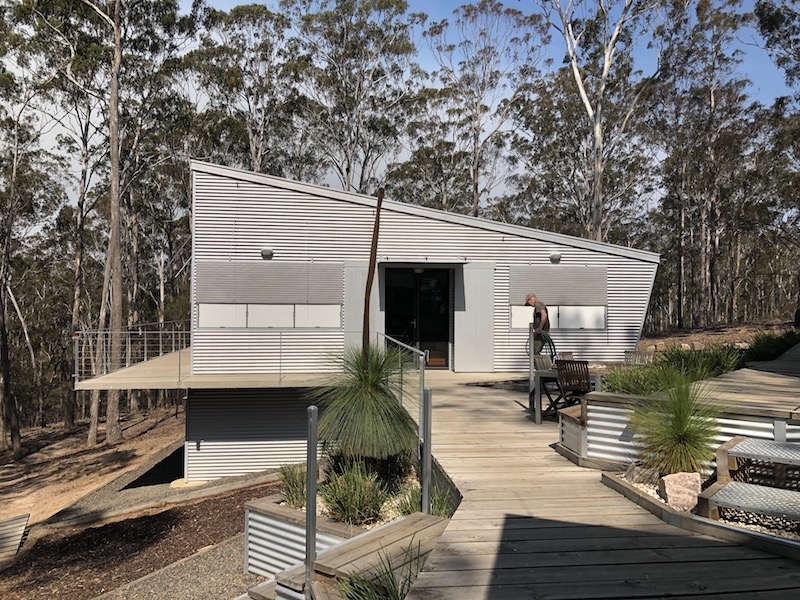
West side of our house and linking decks. Shutters in place and getting ready.
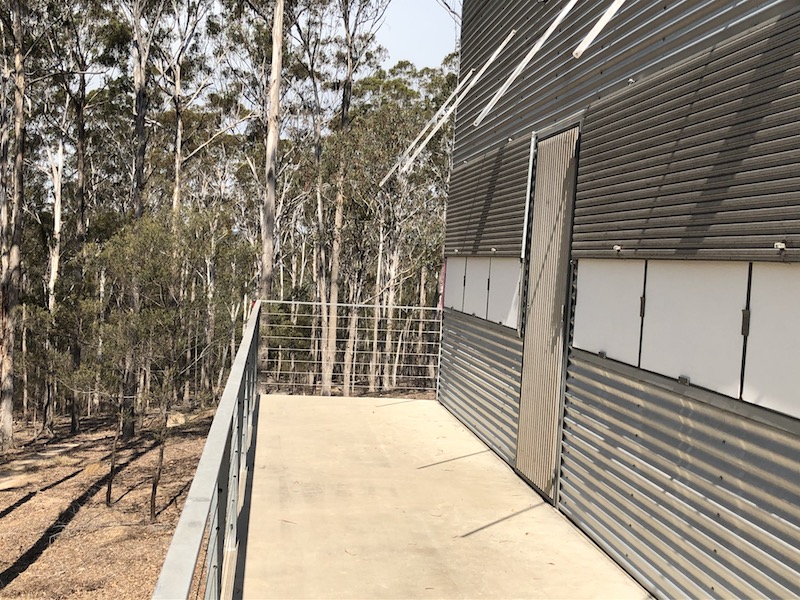
North side of the house and deck, window and door shutters in place.

East side of the house, window and door shutters in place.
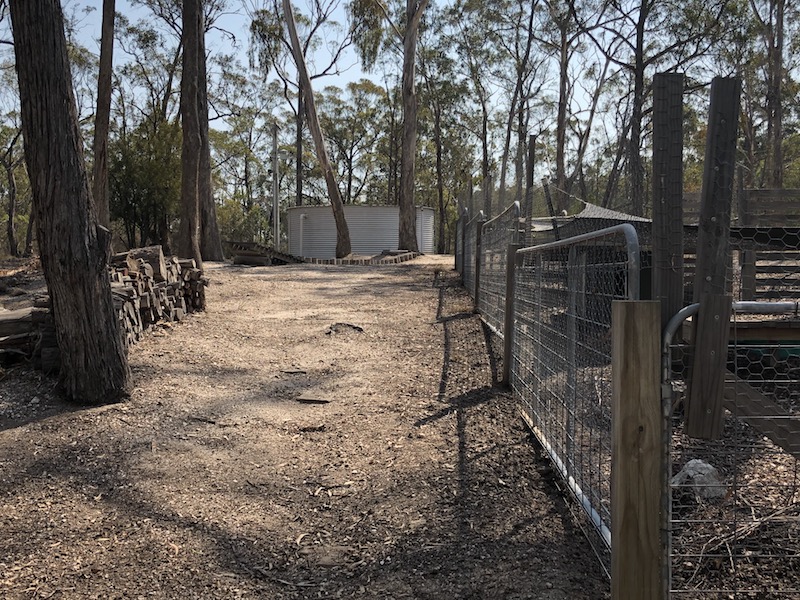
The impact of a powerful leaf blower removing leaf litter around the site.
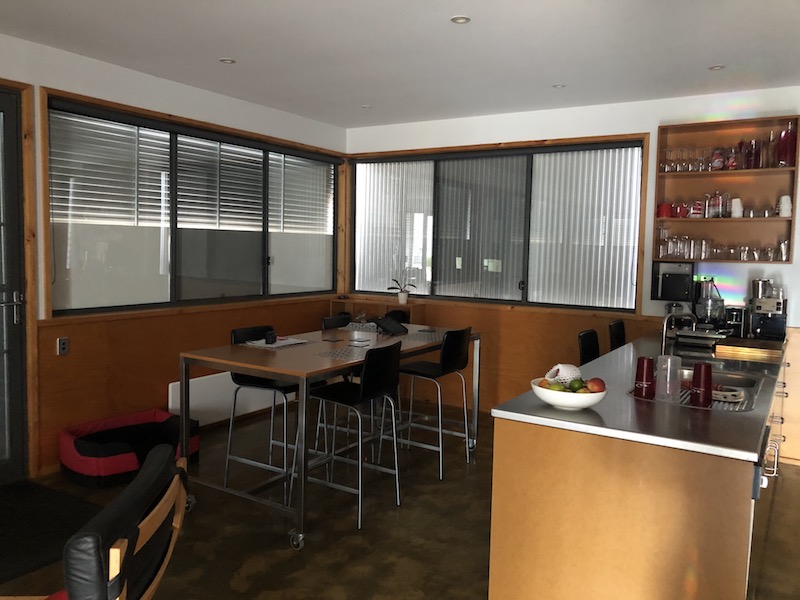
Inside with the shutters in place.
Then it was a case of watching & waiting to see what would happen.
Initially we thought that all the anticipation was for nothing, as it appeared to be relatively quiet out to our north, the direction of the Barmouth Spur Fire.
At around 2.30pm Anthony decided to drive to a high point on the Deptford Road to get a better view of what might be happening, and it soon became evident that the pyro cumulous column being generated meant that the fire was very active.
We spent a long time that afternoon watching the column grow and “lean” right over us and shift gradually to the south west in the prevailing wind. Once again, we thought it might miss us.
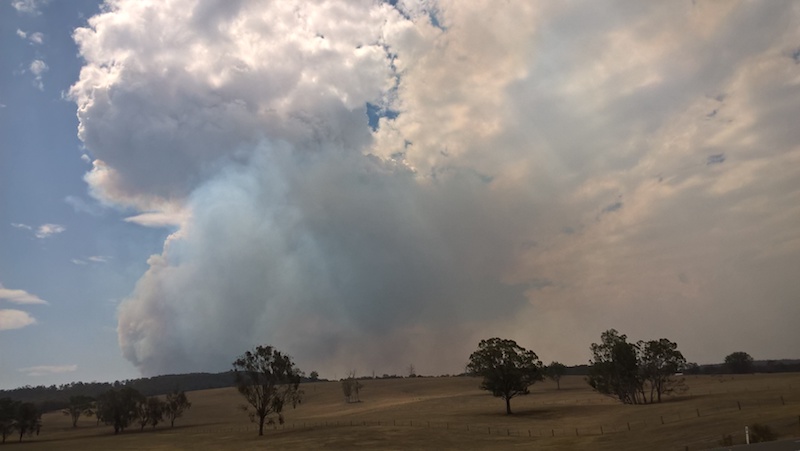
View from the Great Alpine Road west of Sarsfield and looking to the north.
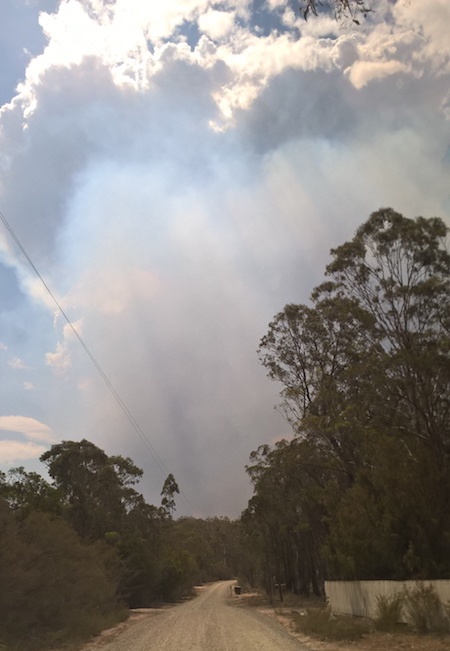
View of the fire looking north along our road.
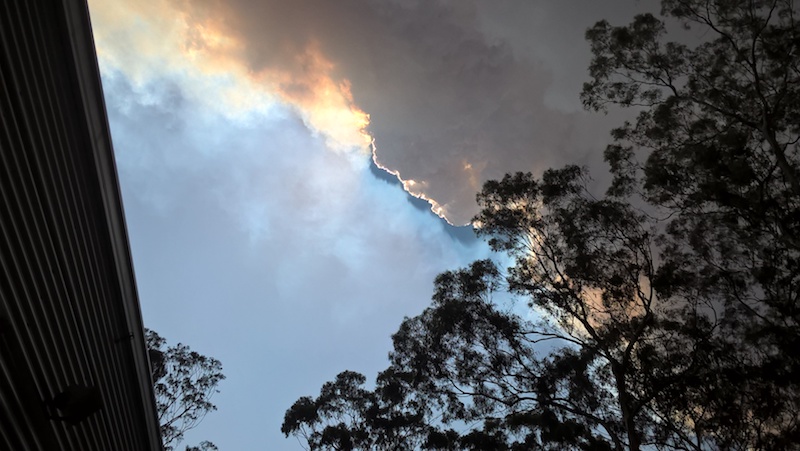
The column “leaning’ over us.
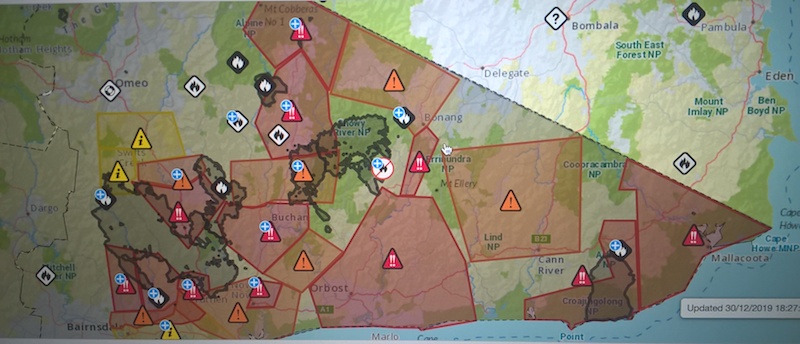
The sad state of affairs in East Gippsland at 6.30pm on Monday 30 December 2019 (at least that was what we thought at the time – it only grew from here)
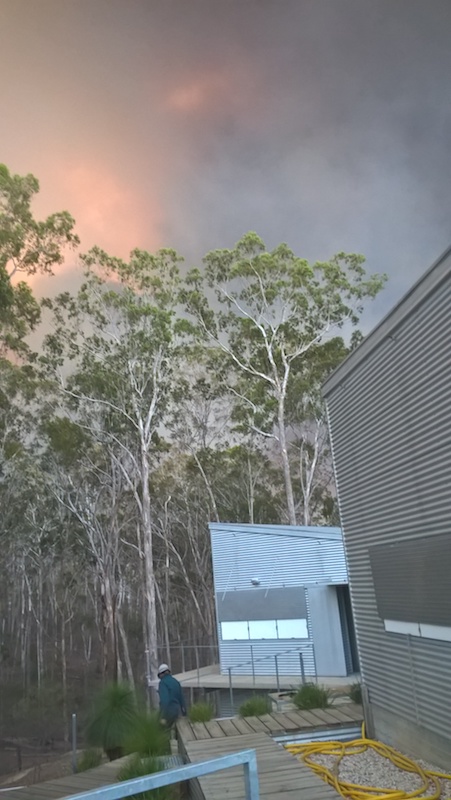
Around 7.00pm
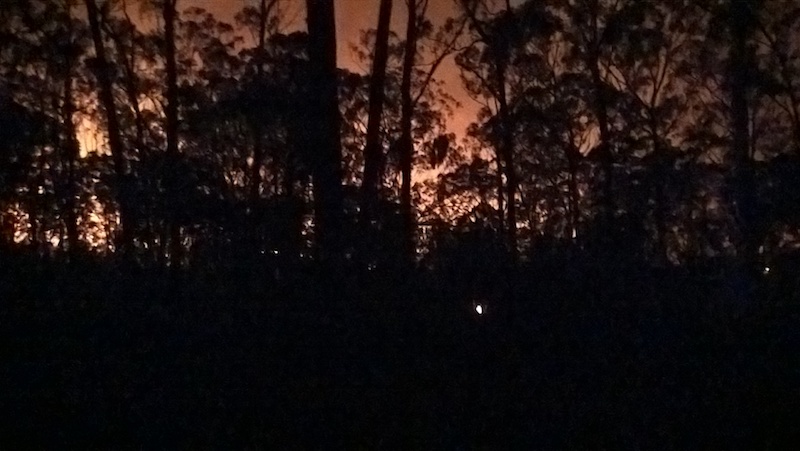
Looking north from our deck, at 9.30pm.
As it grew darker, we were actively watching the fire on the ridges of Old Man Hill directly to our north.
The noise from the fire was a loud roar and we could see the flames being generated as it raced up the back of the slopes to the ridgelines. At times it looked like it was slowing down, but it then it would become ferocious again.
All the time we were watching, we could see that the fire was incredibly active to our east under the north westerly wind – we weren’t sure where, but we knew it was bad. Now we understand why when we drive through Sarsfield.
In the lead up to the fire, I had this text exchange with friends at Eagle Point – they were looking at the Big Red Glow and so were we – just up close!

It all started at around 10.30pm like this:
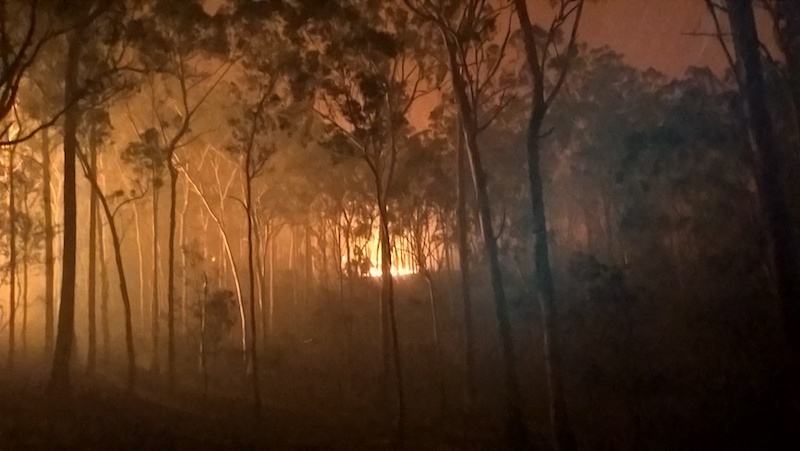
Looking to the north west from our deck.

Looking to the north west from under the house
So, what actually happened during the fire?
Anthony used his GoPro to capture footage during this event. The videos below provide context for the site and the set up we have.
It is amazing, and potentially quite confronting, footage of the event.
The first two videos provide an explanation of our site and set up and will help make sense of the videos taken during the event.
This video is quite long but shows how the fire entered our property and how it grew.
The next three videos show what it was like during the peak of the fire.
Finally, a bit of a look at our place after the fire.
What do you feel in the Big Red Glow?
Hard to describe really! The most tension was prior to the fire entering our property. Wondering in anticipation of what was going to happen. Once it started though we switched into action. It was a case of focussing on your role and making it happen. This is what we planned for.
Reality is I had a support role, checking the inside of the house, keeping our beautiful dog calm and cool in the smoke and heat, and wondering how long the ember shower could actually go on and keeping an eye on Anthony!
Anthony was out and about in the fire, exercising incredible judgment about what was required and racing around making sure it was all going to plan, even chainsawing down a tree near the dog yard that was going to be a problem in the middle of it all.
What do you feel afterward?
Some sort of relief. However, fire experts advise it still isn’t over. Each severe weather day finds the community in a state of heightened anxiety, enacting their fire plan and hoping the warnings aren’t as bad as predicted.
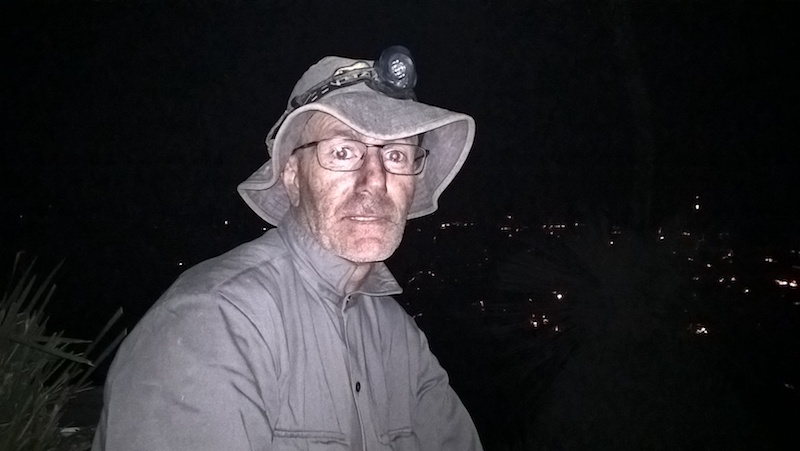
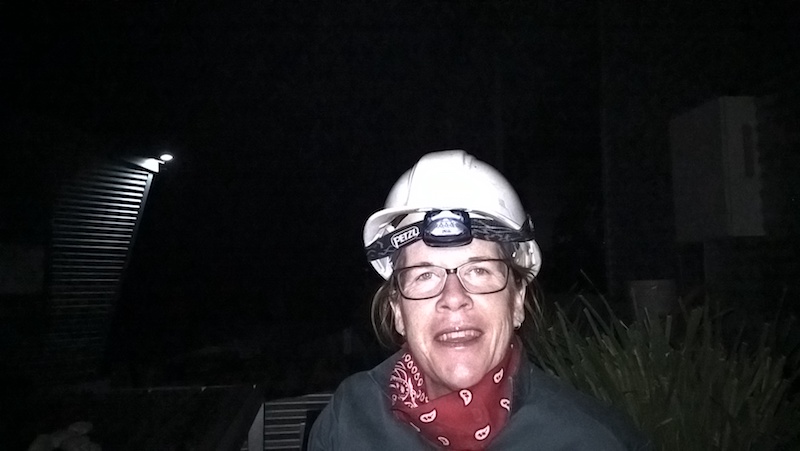
This is what we looked like afterwards though (taken at 1.00am), maybe a bit telling!
Future fire blogs will focus on:
- The aftermath of the fires in Sarsfield, and the East Gippsland community
- What we learned
- The importance of people working together in times of crisis
- Monitoring the recovery of our bush
What is important about our experience?
We appreciate that not everyone has had the knowledge, resources and opportunities that we have had to prepare our property for this event and that every person’s circumstances will be different. But we do think this is important because the content that we have captured gives a real impression of what it is like to experience fire and what might be required to defend your place with confidence.

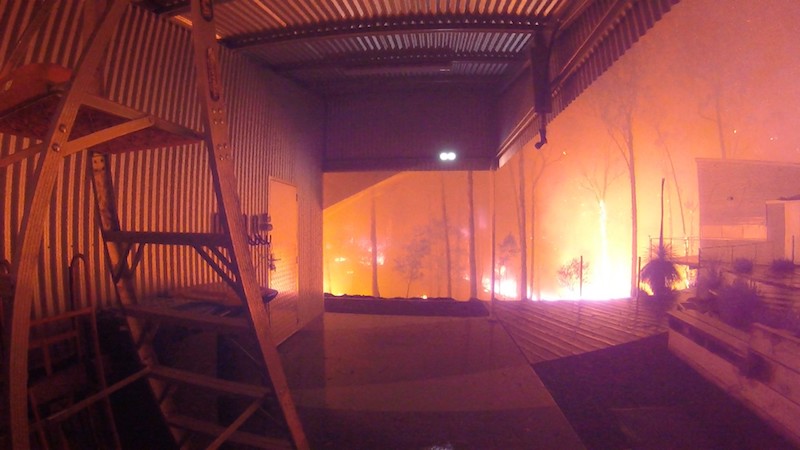
Kate- this is brilliant! It is all in the planning. Assessing one’s capabilities as well. We are more aged than you by twenty years. We evacuated from Clifton Creek preparing our home as best we could before leaving the day before. We had offers from our grandchildren but like you I was working in Omeo during the 2003 fires and heard the horrors others experienced first hand. I vowed never to try to defend.
Hi Sandra. Thanks for taking the time to have a look at what we put together. I totally agree that this is not for everyone. A key reason for publishing this article was to provide some context for understanding what it might be like to experience a fire – so that it might help people exercise good judgement about what they will do in the future. I hope that your place at Clifton Creek is safe. Kate
Brilliant Kate❤
Thank you for sharing your experiences with us.
Your property is a reflection on both of you.
Practical, purposeful, resilient & super cool.
Thanks so much Daniel for your comments! Thanks also for your support and offers of assistance through this – and especially for the amazing coffee – very much appreciated!
Thanks for sharing Kate. I am so glad to hear you and Anthony are okay and that your lovely home survived. I will be sure to show this to my brother who is committed to staying and defending if the fire reaches their home. You have provided great tips and insights about what staying to defend can actually mean. Fingers crossed for the rest of the season.
Thanks Kellinde – please feel free to pass the information on – a big part of the reason for publishing was to provide people with some insight about what it is like to stay and defend if that is the choice people want to make.
Great presentation. Your success was the result of much long term planning starting with the design and construction of the buildings. The lack of vegetation close to the buildings was also a very important part of your strategy. I would also have expected the first ignition to have been from the North. Having spoken to a few people since the fire, I guess it makes sense the Airborne Embers precede the main fire front, and can pass over you.
Your sprinkler system certainly did its job of protecting the decking and underneath especially. I am curious as to your water supply. I noticed a large tank. Did you also have petrol/diesel pumps/generator as I a backup?
Well done . A great source of knowledge for those rebuilding, or preparing for next time.
Hi Graeme. Thanks for your feedback. We have two petrol pumps and a tank that is connected to the reticulated water supply – so we aren’t reliant on tank water or the reticulated system during an event. I will publish some more detail about the system and how it is set up and the redundancy built in – and also a bit more detail about what we learnt from the event and would do differently or improve. If you think others might be interested, please feel free to share.
Thank you for your insight in what it requires to defend your home during an extreme fire event Kate&Anthony.
Well done
Cheers Maria&Brendon
Hi Maria and Brendan. Thanks very much for watching/reading and for your comments. It has been an interesting experience! Hope you are both well. Kate
Thank you so much.
Thanks Kate & Anthony. Very informative and interesting. Glad you were both safe from the bushfire and able to defend your house successfully. Think the hardest lessons are those we learn through experience.
Best wishes Kate and Anthony. Thank you for sharing this experience and showcasing the preparation, investment, risk assessment and the planning for this challenge. Best of luck in the future. Greg
Thank you for sharing and thank goodness you lived to tell the tale. I would not like to think though that this gives a false sense of security as other stories, as you have intimated, suggest that the weather that certain fires bring about would not allow for survival. Such a terrible time.
Hi Kate, it was great to read your story and amazing to watch your footage. I can see how well prepared you were, but I still think you’re very brave staying, I ran! You must have been physically and emotionally exhausted after this. You both did a great job. Thanks for sharing.
Hi Kate and Anthony,
An amazing and inciteful documentary of what it takes to survive a fire storm. The 5 P’s certainly held you in good stead. Your prior preparation certainly paid off, as did your bravery and resilience. Thanks for sharing this.
Firstly, well done on your well thought out and implemented planning, construction, infrastructure, maintenance, and action. Having put all that hard work into place must have given you both a degree of confidence going into, during and even at the height of the bushfire. I also think it’s great your local community look out for each other in times of crisis such as a major bushfire.
One thing I took from reading the CSIRO report on the Dec 2015 Wye River bushfire was (with the embers passing overhead on the winds ahead of the fire front) the embers ignited bush and leaf litter down hill from and down wind of homes, then I gather with the assistance of the upslope burnt up hill against the prevailing winds with sufficient radiant heat from the burning bush and leaf litter to ignite homes before the actual fire front reached the township. So planning for such contingencies through redundancy built into your fire planning, action and sprinkler infrastructure looked to be another critical aspect of your overall successful defense.
Also, the (what may seem like little things) blowing away of the leaf litter ahead of the bushfire and around fence posts, tree trunks etc in tandem with the sprinklers in the areas not blown away looks to be another critical step in your overall successful defense of your home and property (which thankfully for your stay and defend plan serves to protect your lives).
Another thing I took from the Wye River report was the importance of not storing any combustibles under your house that can ignite, in addition to removing all leaf litter etc in and around the home. The use of timber retaining walls was also a concern. With the steep terrain and invariably elevated homes, storage with just perforated mesh for security looked to be another critical factor in whether a home survived or not. Where subfloor areas weren’t enclosed by corrugated iron on your home to protect from ember attack, the open areas looked to be virtually sterile of storage, leaf litter, etc, so well done again on all that.
You being on town mains thereby all but ensuring your large static water storage tank was full for bushfire sprinkler and fire fighting purposes ahead of the bushfire was a bonus (where I gather the mains ceased to be effective once the fire front hit). Also, having that large secure space under the house for your petrol pumps, 30m hoses, etc looked to be another critical aspect of your overall planning. I understand diesel needs to be disposed of at select intervals for the pumps to work so perhaps running petrol pumps may be more practical for a domestic setup.
I’m so glad it all came together for you both & your pet, and (I gather) for all your Neighbours. Having not grown up in the bush but understanding from all reports that staying to defend isn’t and shouldn’t be for the majority, your success story is one of the exceptions and a credit to you both!
Mark Cooper
Thanks very much for your detailed comments Mark. Being confident in your system, your preparation and your own capability is critical and yes unexpected things do happen!